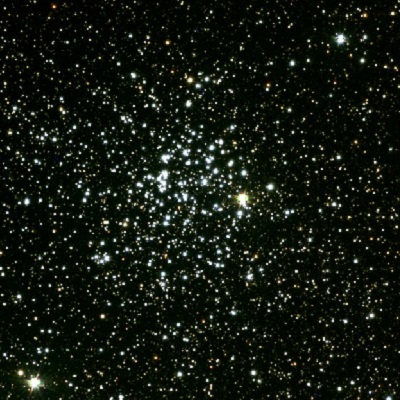M52 is a magnitude +7.2 open cluster located in western Cassiopeia. This excellent grouping of stars is one of the best clusters in the northern Milky Way, with some 200 members spread across 13 arc minutes of apparent sky. It can be seen in binoculars and is a wonderful sight through telescopes, appearing rich and bright with dozens of mainly white stars visible.
M52 was one of Charles Messier's original discoveries, which he cataloged on September 7, 1774. He spotted it when a comet he was observing passed close by. The cluster is easy to find since it's located one degree south of star, 4 Cas (mag. +5.0). An imaginary line from Schedar (α Cas - mag. +2.2) extending towards Caph (β Cas - mag. +2.3) and again for about the same distance also leads to M52.


Finder Chart for M52 - pdf format (credit:- freestarcharts)
Through 10x50 binoculars, M52 appears somewhat fan, kidney or V shaped with a prominent 8th magnitude yellow star at the southwest corner. An 80mm (3.1-inch) telescope reveals a concentrated cluster of mostly faint members, that's best seen using averted vision. It appears like a sprinkling of salt and pepper, spread over an area just less than half the apparent size of the full Moon. A small increase in aperture, enhances the fan shape and the overall appearance of the cluster. A 150mm (6-inch) scope, reveals at least a dozen stars surrounded by a round diffuse haze, with the bright yellow star prominent. With the help of averted vision, the background haze resolves into about 50 or so faint stars. In even larger telescopes, M52 is brilliant with dozens of stars clearly visible. Due to interstellar light absorption, the distance to M52 is difficult to accurately determine. Estimates range between 3,000 and 7,000 light-years. Assuming a value of 7,000 light-years, then M52 has a spatial diameter of 26.5 light-years. It's estimated to be 35 million years old.
M52 is best seen from the Northern Hemisphere during August, September and October, where it appears high in the sky or even overhead from some locations. From latitudes greater than 28N, the cluster is circumpolar. Along with NGC 457 and NGC 7789, it's one of the finest clusters in the northern Milky Way. NGC 7635, the Bubble Nebula, an unusual emission nebula is 0.5 degrees southwest of M52.
M52 Data Table
| Messier | 52 |
|---|---|
| NGC | 7654 |
| Object Type | Open Cluster |
| Constellation | Cassiopeia |
| Distance (light-years) | 7,000 |
| Apparent Mag. | +7.2 |
| RA (J2000) | 23h 24m 50s |
| DEC (J2000) | 61d 36m 24s |
| Apparent Size (arc mins) | 13 x 13 |
| Radius (light-years) | 13.25 |
| Age (years) | 35 Million |
| Number of Stars | 200 |
| Other Name | Collinder 455 |